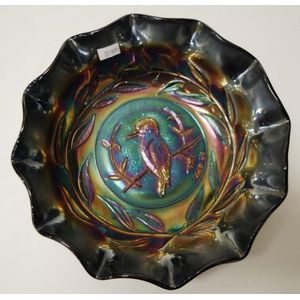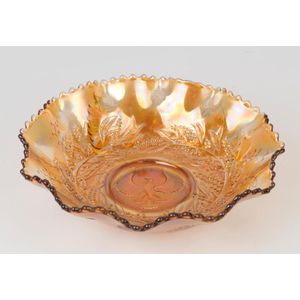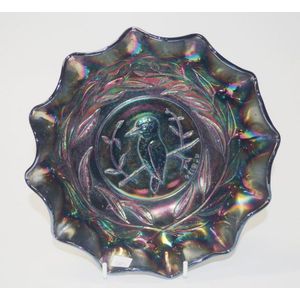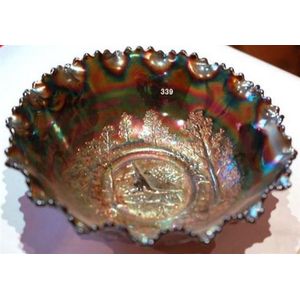
Collection of Australian Carnival Glass Items from Prominent Collector
A group of ten carnival glass items, comprising an Australian Crown Crystal Piping Shrike (Thunderbird) master bowl in dark with ruffled edge on a collar base, together with 9 other carnival glass items from the estate of a prominent Australian collector.…

Australian Amethyst Carnival Glass Master Bowl with Kookaburra Pattern
Australian amethyst carnival glass master bowl pattern: Kookaburra, Rd. 4184, width 24 cm

Cobalt Emu Carnival Glass Set: Bowl and 5 Dishes
Cobalt emu and flannel flower carnival glass master bowl and five dishes (6 items), the largest 25 cm wide

Crown Crystal Shrike Carnival Glass Master Bowl
Carnival Glass 'Shrike' marigold master bowl by Crown Crystal, circa 1920s 8 cm high, 25 cm wide

Amethyst Carnival Glass King Fisher Bowl with Gum Leaf Wreath
Amethyst Carnival glass King Fisher master bowl with gum leaf wreath border, diameter 24 cm

Amethyst Kingfisher Carnival Glass Master Bowl
Good amethyst carnival glass Kingfisher bowl master bowl, embossed decoration of leaves, with Kingfisher to centre, marked Rd 4184, diameter 24 cm

Kingfisher Carnival Glass Bowl with Embossed Leaves
Good amethyst carnival glass Kingfisher bowl, master bowl, embossed decoration of leaves, with Kingfisher to centre, marked Rd 4184, (diameter 24 cm).

Marigold Kangaroo Carnival Glass Master Bowl - 24cm Diameter
A kangaroo Carnival glass master bowl, in marigold. Diameter 24 cm.

Marigold Carnival Glass Master Bowl with Bird Motif
Piping Shrike Carnival glass master bowl (Australian) in marigold with bird and floral motif and tissue shape, diameter 25 cm

Kingfisher Carnival Glass Master Bowl with Gum-Leaf Wreath Border
Australian carnival glass Kingfisher master bowl, black amethyst, with gum-leaf wreath border. Diameter 24 cm approx.

Black Octagonal Rim Glass Bowl by Magpie Carnival
Magpie Carnival glass master bowl in black with octagonal rim, diameter 25 cm

Marigold Kookaburra Carnival Glass Bowl with Butterfly and Waratah
Kookaburra Carnival glass master bowl with butterfly and waratah in marigold, diameter 24 cm

Australian Black Amethyst Carnival Glass Master Bowl "Kingfisher"
An Australian black amethyst Carnival glass master bowl 'Kingfisher' RD4184 stamped. Diameter 24 cm

"Piping Shrike" Amethyst Carnival Glass Master Bowl
Amethyst Carnival glass master bowl, 'Piping Shrike', 24 cm diameter

"Piping Shrike" Amethyst Carnival Glass Master Bowl (24cm)
Amethyst Carnival glass master bowl, 'Piping Shrike', 24 cm diameter

Amethyst Kangaroo Carnival Glass Bowl - 24cm Diameter
Amethyst Carnival glass master bowl, 'Ruffled Kangaroo', RO4696, 24 cm diameter

Amethyst Kangaroo Carnival Glass Master Bowl - 24cm Diameter
Amethyst Carnival glass master bowl, 'Ruffled Kangaroo', RO4696, 24 cm diameter

Amethyst Magpie Carnival Glass Master Bowl
Amethyst Carnival glass master bowl, 'Magpie', 24 cm diameter

Amethyst Carnival Glass Master Bowl with Stippled Rays
Northwood stippled rays amethyst carnival glass master bowl

Marigold Carnival Glass Kangaroo Master Bowls with Foliate Detail
Marigold Carnival glass kangaroo pair of master bowls having frilled edging, raised foliate detail & a central kangaroo medallion. RD4696, made by Australian crystal glass Company circa 1924. Condition: good, minor wear to the bases. Diameter 24 cm

Marigold Carnival Glass Kingfisher Variant Master Bowls (Pair)
Pair Marigold Carnival glass Kingfisher Variant master bowls. Marked Rd. 4184, diameter 25 cm (each)

Amethyst Kookaburra Carnival Glass Master Bowl (D24cm)
Amethyst carnival glass kookaburra master bowl d24 cm approx

Embossed Emu Master Bowl - Marigold Carnival
Marigold Carnival emu master bowl. Standing emu embossed to centre. Diameter 25 cm

Regulation Kangaroo Carnival Glass Bowl with Small Chip
A carnival glass master bowl kangaroo, with regulation number, small chip to rim

Amethyst Kookaburra Carnival Glass Master Bowl - 24.3cm
Amethyst carnival glass kookaburra master bowl 24.3 cm wide

Kingfisher Marigold Carnival Glass Master Bowl - 24cm Depth
Marigold Carnival glass master bowl. Kingfisher. Depth 24 cm

Kingfisher Marigold Carnival Glass Bowl (24cm)
Marigold Carnival glass master bowl. Kingfisher. Diameter 24 cm

Kangaroo Carnival: Amethyst Master Bowl (24cm)
Amethyst Carnival glass master bowl. Kangaroo. Diameter 24 cm

Amethyst Kangaroo Carnival Glass Master Bowl
Crown glass amethyst Carnival glass master bowl with kangaroo decoration, 24.5 cm wide, 8 cm high approx

Amethyst Carnival Glass Kangaroo Bowl
Amethyst Carnival glass master bowl. 'Kangaroo' registered design RD4696 c.1924. Made by Australian crystal glass Company. Some wear to lustre. Diameter ia. 24 cm

Amethyst Kangaroo Carnival Glass Master Bowl
Amethyst Carnival glass master bowl. 'Kangaroo' registered design RD4696 c.1924. Made by Australian crystal glass Company. Slight wear to lustre. Diameter ia. 24 cm

Australian Amethyst Carnival Glass Bowl with Kingfisher Design
Australian amethyst carnival glass master bowl with kingfisher, 24 cm wide

Australian Amethyst Carnival Glass Bowl with Shrike
Australian amethyst carnival glass master bowl with shrike, 25 cm wide

Australian Kangaroo Amethyst Carnival Glass Master Bowl
Australian amethyst carnival glass master bowl with kangaroo, 24 cm wide

Australian Kangaroo Carnival Glass Master Bowl
Australian iridescent Carnival glass kangaroo master bowl (Rd number 4696)

Cobalt Blue Carnival Glass Bowl with Swan and Bells
Australian cobalt blue Carnival glass master bowl with 'Swan and Christmas Bells' pattern. Rd. 4696 24 cm approx 24 cm diameter

Cobalt Blue Carnival Glass Bowl with Swan and Bells Pattern
Australian cobalt blue Carnival glass master bowl with 'Swan and Christmas Bells' pattern. Rd. 4696 24 cm approx 24 cm diameter

 Loading more...
Loading more...